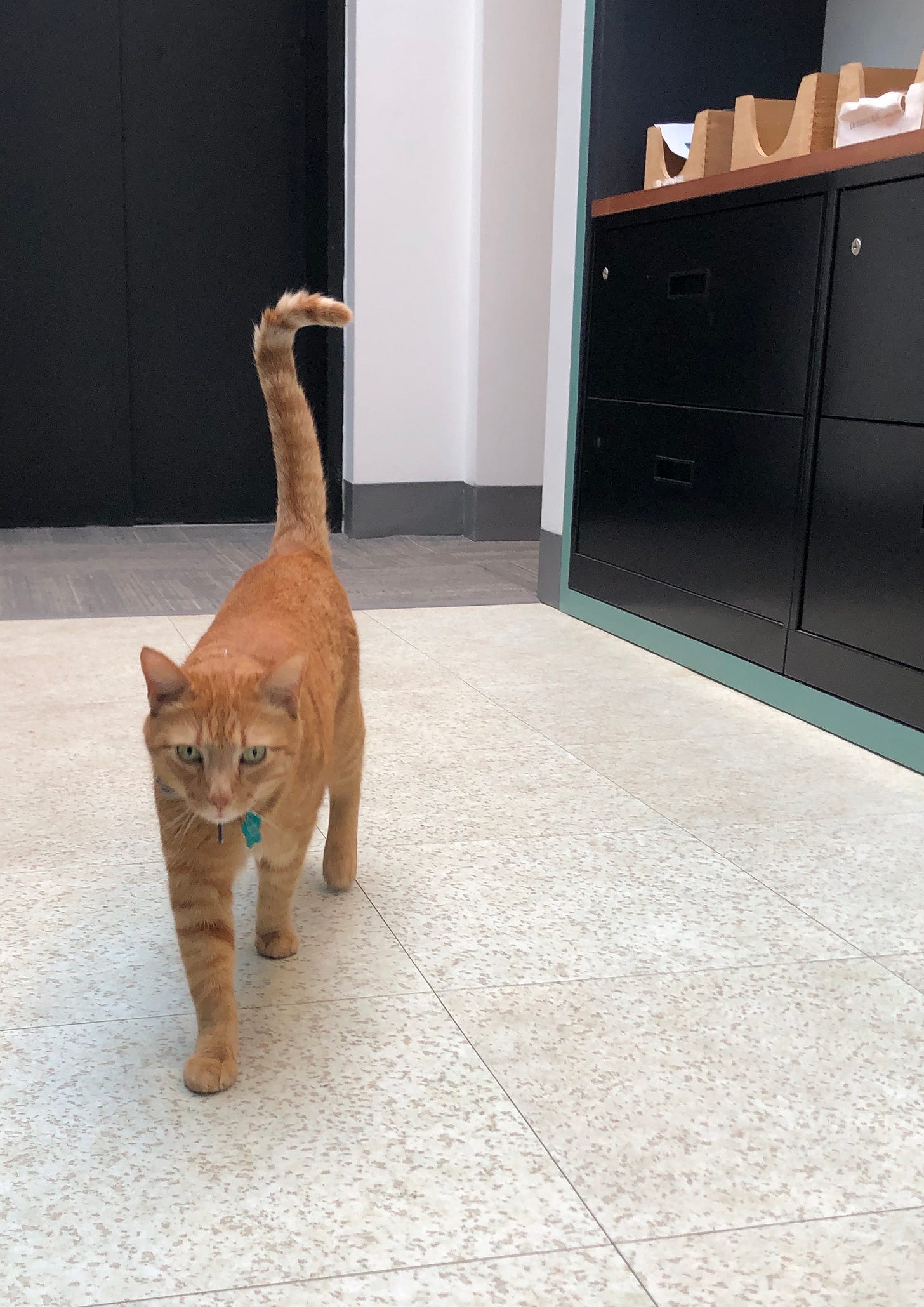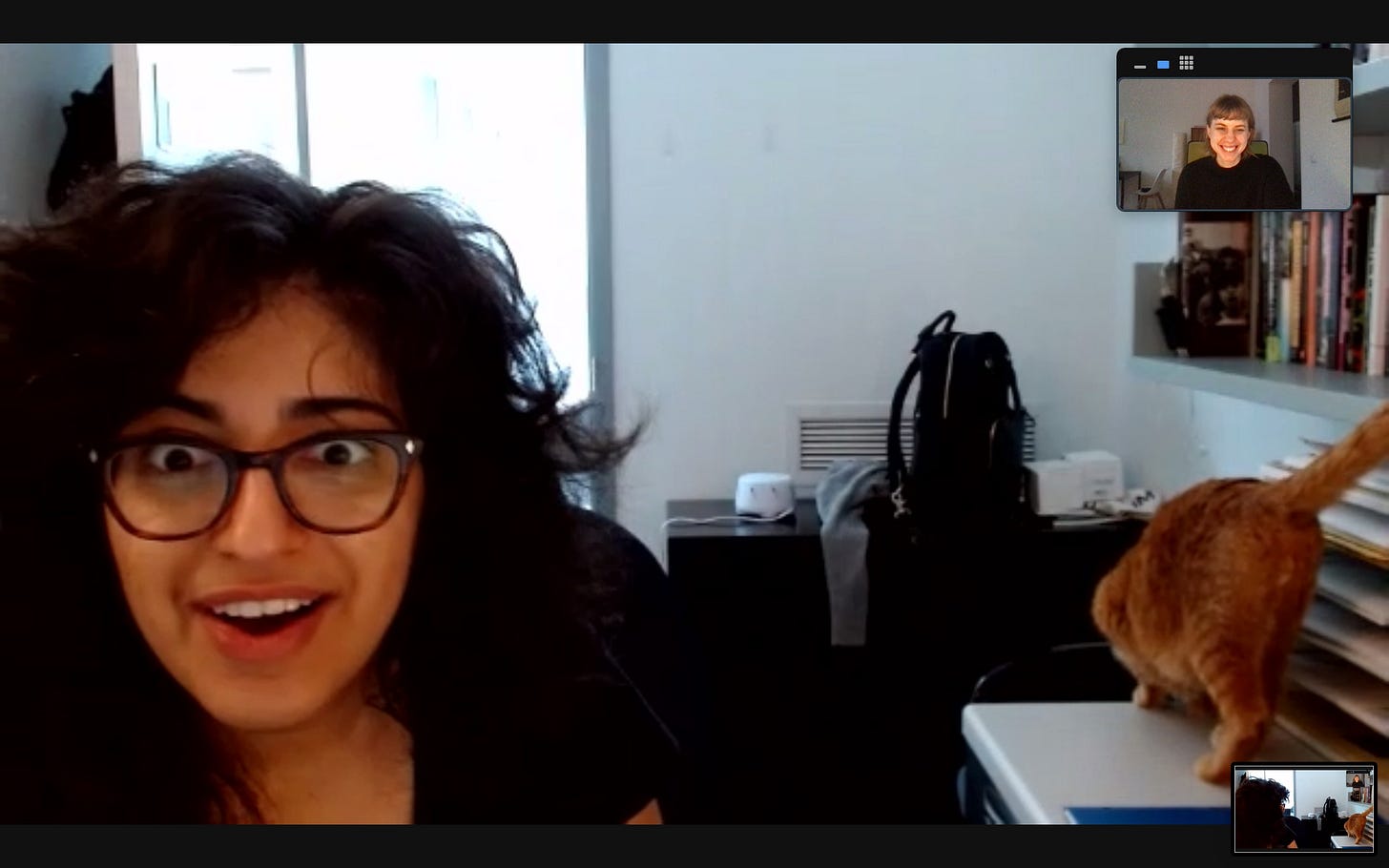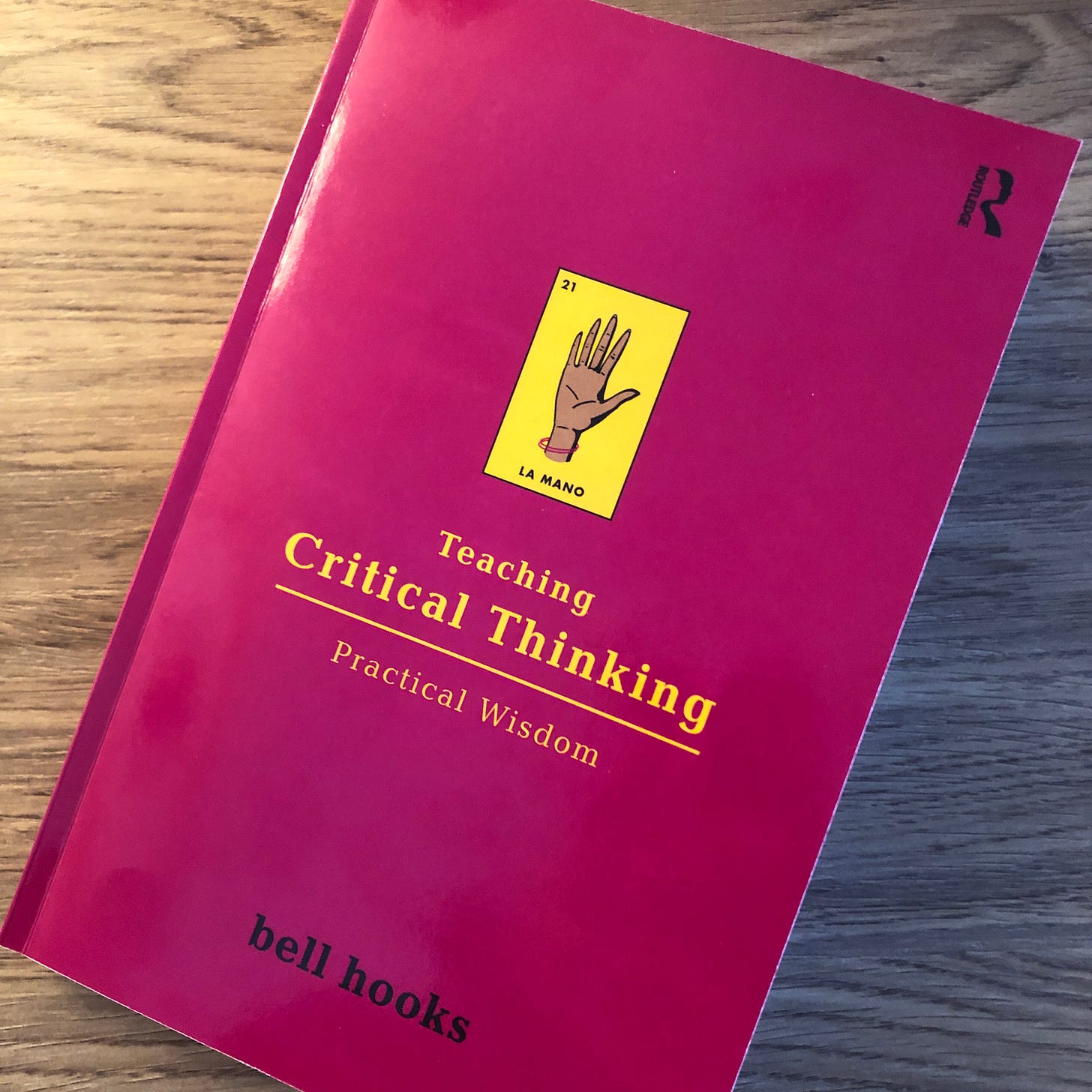80. 💥 punching up 💥
thinking about little ways to just keep going
Hello, and happy Monday.
Last Thursday morning, the Warren Center got a surprise guest when they snuck into the elevator with me. For those of you who aren’t yet acquainted, meet Remy the Harvard cat:
He is an outdoor cat who belongs to a family near Cambridge. Often, he makes his way over to campus and has his run of the buildings. This was my first close encounter with him, so of course I took a lot of pictures as he explored the Center:
At one point, while I was co-working with my friend Zsofi, he even managed to hop up on the desk, which gave me quite a scare:
I eventually had someone else help me lure him to another floor, because I am allergic to cats and was starting to feel sniffly. Nonetheless, he was very cute and chill. Thank you for visiting, Remy! 😺
✏️ Still processing.
This week, I finally finished my bedtime book: Wow, No Thank You by Samantha Irby. (For those of you who are not familiar with her writing, I highly recommend literally all of her essay collections for a good, hearty laugh.) This is her third collection of essays, and it’s always so lovely hearing about her live and how it has changed since the publication of her first book, Meaty. One of the opportunities that writing publicly has given her has been writing for television. Wow, No Thank You features an essay about her experience writing for Hulu’s Shrill (based on the essay collection by Lindy West), which was her first time in a writers room. At one point, she talks about all the new vocabulary terms she encountered with writing for the screen and writing in comedy, one of them being the phrase “punching up”:
“Punching up” basically means that other writers go through your script and try to come up with lines that are funnier than yours, and you get to do the same thing to theirs; then everyone submits them anonymously and the producers who get final script approval pick the ones that they like best and they’re probably not yours but whatever, bitch!
(A brief aside: even here—in these few lines—you can see her amazing writing style, which is why I really recommend her work!)
It was this idea of “punching up” sparked an idea for my writing practice last week.
Sometimes, even when I try to embrace the concept of the “shitty first draft,” my inner perfectionist rears its head. I can’t move on from a sentence or a word, it seems, without feeling that it must be perfect before I can continue. This especially gets in the way when I’m trying to write out a train of logic, and I inevitably forget where I am in communicating the larger concept. I seem to get stuck in the weeds.
I decided to spend last week trying to implement the following solution: when I would inevitably get stuck on a word or a phrase that I didn’t like (Google Docs has been my word processor of choice recently), I would highlight whatever was troubling me and write “PUNCH UP” in the comment box that appears at the margins. Then I would spend a little time (like less than a minute) stream-of-consciousness riffing on what I wanted to say. Here’s an example of me practicing this for a talk that I’m giving later this week:
When I’m able to notice that I’m ruminating on something small, it’s been a great help to just fire off some ideas and move on. This is a first draft, after all. I tell myself that when I start my revisions, the brief alternatives and feelings that the original phrase evokes for me will help me get back in the mindset of when I was originally writing. The only difference it would happen during my revision process, rather than the time when I just need to get words down on paper.
I’ve also found that doing this has made me think of words as less precious. By just listing out words—even ones that seem “wrong” to me still but that come to mind—I am letting that “faucet” of thoughts empty so that I can get closer and closer to what is going on inside my head.
While I’ve only “punched up” my own writing recently, this passage also reminded me of the joy of working and collaborating with others on writing. Co-working has definitely combatted my feelings of isolation, so now I can think more expansively about the ways that I want to connect with others through my writing as well.
📚 Still reading.
Part 2 of 3
hooks, bell. Teaching Critical Thinking: Practical Wisdom. New York: Routledge, 2010.
This week, I compiled some summaries and reflections on Teachings 11 through 20 (you can read my thoughts on Teachings 1-10 here). I hope you enjoy, and that you see this compilation as an invitation to read those essays that spark further interest in you. 🤗
Imagination: hooks asserts the value of imagination—not only in the classroom, but also in shaping our future. So much of our ability to imagine in childhood has been stamped out as we have grown older, as we are meant to fall in line with the status quo. But, hooks states, “Without the ability to imagine, people remain stuck, unable to move into a place of power and possibility, (61). The classroom can serve as a space from which we practice imagining once again—where we center its value in thinking about alternatives. When I was reading, I kept thinking of the phrase, “imagine otherwise,” which I think gets at what hooks sees as the ultimate aim of this practice.
To Lecture or Not: When evaluated in its capacity to teach, hooks does not see the lecture as valuable to the cultivation of active learners. Rather, environments where one can engage in a dialogue with others about ideas, where one is allowed to unashamedly say that they don’t know the answer to a question, where one can pause and clarify in real time—that is a space of learning for hooks. The value of lectures, she believes, comes from those who are just beginning to engage with your thinking: “The best benefi of the large lecture is that it brings new readers to one’s work...it is a moment of preparation for learning that will take place somewhere else, at another time, away from performance and spectacle,” (68).
Humor in the Classroom: Humor in a learning space can be used for showing vulnerability and for beginning dialogue around conflicting views in the classroom. hooks primarily meditates on humor through witticisms—was I surprised to see “read” and “throwing shade” used in this essay! But it was actually earlier on in her essay that I saw her get at the heart of the reasons why we must inject humor into the classroom: “Classes where students are learning new ways of thinking and knowing that may challenge all the belief systems they have heretofore held dear need humor as a mediating force,” (72).
Crying Time: “Weeping, crying, wiling, all displays of emotional intensity are feared in the classroom because they upset the hierarchy that would have us assume that the mind should always have dominion over the body and spirit. We are called to learn beyond the boundary of language, of words, where we share common understanding. We are called to learn from our senses, from our feeling states, and find their ways of knowing. If we allow for the possibility of tears, then an insurrection of subjugated knowledge may occur,” (83).
Conflict: hooks makes the distinction between “safety” in the classroom as one where everyone has the same opinion versus one where students are encouraged to engage in positive dissent and conflict with their peers, knowing that they are doing so in a space of mutual respect and openness. “When we teach our students that there is safety in learning to cope with conflict, with differences of thought and opinion, we prepare their minds for radical openness. We teach them that it is possible to learn in diverse teaching settings. And in the long run, by teaching students to value dissent and to treasure critical exchange, we prepare them to face reality,” (88).
Feminist Revolution: The value of feminist thinking and its sustained development in institutions of higher education is apparent in the ways that it has contributed to the possibilities of learning and thinking. One of my favorite lines that appears in this essay is hooks’ assertion that universities and colleges have “embraced” feminist thinking as “simply yet another way of knowing,” (94). This, to me, is such a gift—that we can see different approaches to understanding information as sitting alongside one another without judgement. We take what we need from these modes of thought as a way to understand the world around us.
Black, Female, and Academic: In this essay, hooks unpacks stereotypical representations of Black women—as caretakers, as angry, as sexualized, as mean—and how this manifests in spaces of teaching and education. The following passage particularly resonated with me: “When I began writing and teaching about the connections between racism and sexism, I was often told that I was so angry. I refused to accept this projected identity. Instead, I would challenge audiences to consider why analysis of race, gender, and class that called into question accepted ways of thinking always appeared to them to come from a place of anger rather than a place of awareness,” (101).
Learning Past the Hate: This is probably the most thought-provoking essay of this section for me. So much here speaks to the ways in which we can still resonate with work that may fail us as it reinscribes (in some way) the reality of living in a heteropatriarchal, capitalist, white supremacist society. The way in which we consume such texts should be critical and should recognize the particular political, social, and historical contexts from which it arose. As hooks states, “When I approach any writer who created during a historical moment when prejudicial thinking was more accepted, I approach their work from a standpoint that includes an awareness of multiple intentions...If the work of that writer speaks to my soul...my mind will choose to focus on the aspect of that work that I find compelling,” (106-107). To pair with adrienne maree brown’s We Will Not Cancel Us.
Honoring Teachers: “When teachers are revered, admired profoundly and respectfully, our ability to teach is enhanced as is the ability of our students to learn. This is misunderstood often in Western societies where reverence is confused with subordination. To honor a teacher with reverence does not require subordination. In a democratic society where there is so much emphasis on equality, there is a tendency to forget that inequality does not necessarily mean domination is taking place,” (114).
Teachers Against Teaching: For me, this was an essay that promoted the value of teaching evaluations, especially when they are critically constructive and come from students’ desires to have a classroom experience that is engaging and where they are actively learning. Just as students must recognize that they are mutual contributors to the atmosphere and experience of a classroom, they also should feel empowered to let the professor know the ways in which the classroom can be set up for a healthy and engaged learning community to emerge.
I’ll be back next week with the final installment of hooks’s Teaching Critical Thinking!
🌀 Still consuming.
In the bookshop:
Currently Reading: The Death of Vivek Oji by Akwaeke Emezi
On Deck: The Lying Life of Adults by Elena Ferrante
Remy has an instagram (above)! Keep up with his antics there!
A critique of the term “writer’s block,” courtesy of friend & tiny driver reader Celine N.
My amazing friend and art historian extraordinaire Zsofi V.N. wrote an article on NFTs and the gobbledy-gook that is crypto-speak. Thank you for this insight, Zsofi! 💗
Another take on the dark academia aesthetic.
What happens when discourse on structural racism makes its way across the pond?
This article paired with my “Focus” setup on my iPhone.
📖 Book club corner.
For February’s book club, we will be reading bell hooks’s All About Love: New Visions. I am so excited! Feel free to purchase the book here, and the details are below!
Here’s the event info:
Date & Time: February 22 at 5PM PST/8PM EST
Registration link!
Suggested Donation (for those able to donate): $3-10 through Paypal or Venmo (@idyalz)
If you'd like to learn more about the tiny driver book club, click here!
🐶 A pup-date.
Higgins got to meet a non-sentient, corporate-sponsored doggie recently. Don’t worry, though, this is not #sponcon!
As always, thanks so much for reading through, and I'll see you in the next one!
Warmly,
Ida










Great read!
I’ve often spent way too much time ruminating on my use of specific words especially if it’s for a major submission. “Punch Up” seems to be a wonderful way of instilling a sense of momentary detachment from the materiality of words and focusing instead on the essence of what one is trying to say.
I love this idea of punching up as an editing tool! Thanks 💜